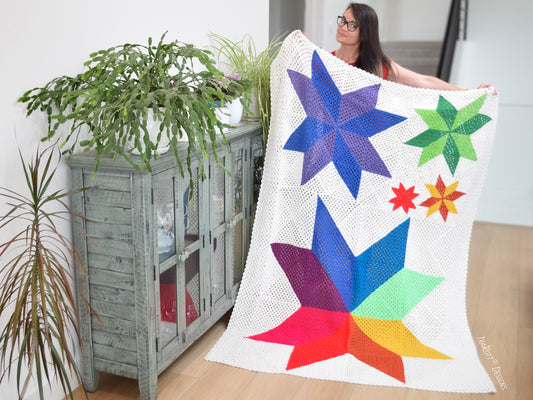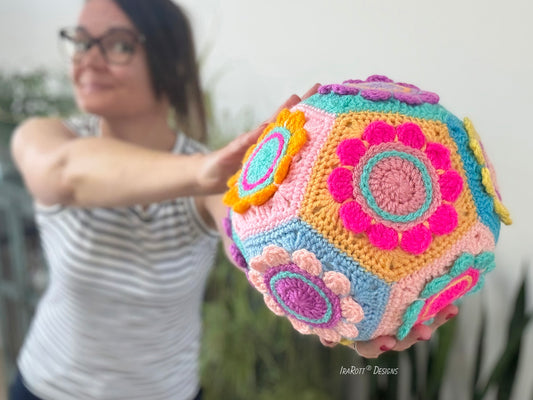Sometimes you look at your double-crochet project and notice the seam leaning at an odd angle, the fabric feeling a bit too airy for a cozy hat, or a gauge that refuses to match no matter how many swatches you make. The culprit often isn't your tension; it’s likely the sneaky difference between Yarn Over (YO) and Yarn Under (YU) double crochet.
These two techniques are like twins with opposite personalities: both create beautiful dc stitches, but one keeps it straight and flowy, while the other adds a counterbalanced slant for perfect symmetry. Most crocheters stick to the “traditional” way they learned, but switching can transform your projects.
This is Part 1 of our deep dive into crochet basics (check out Part 2: Single Crochet and Part 3: Half Double Crochet for more). Let’s break it down so you can choose the style that works best for you.
How to make Double Crochet (Dc) - Two Ways
Both YO and YU dc start the same: Yarn over, insert hook into the stitch… and then the paths diverge. One tiny wrist flick, and boom...your stitches behave differently.
 |
Yarn Over (YO) Dc: 1. Yarn over, insert hook into stitch This stich is known as a Traditional Dc. |
 |
Yarn Under (YU) Dc : 1. Yarn over, insert hook into stitch This stich can also be referred as “Hook Over”. |
How the Stitches Look Up Close
Many crocheters note that Yarn Under causes the base legs of dc to cross or twist, rather than run parallel as in Yarn Over.
YO double crochet:
- Straight stitch, like a crisp “I”
- Offset placement from row to row
- Slightly taller and airier fabric (great for drapey projects)

YU double crochet:
- Slanted stitch, like a stylish "\" (right-handers) or “/” (left-handers)
- Counterbalanced placement from row to row
- Slightly shorter and denser fabric (holds shape well)

The Magic and Mischief of Joined Seams in the Round
When the hook is inserted under both loops of the stitch below, the new stitch naturally shifts slightly to the right (right-handers) or left (left-handers), because the top of the stitch doesn’t sit directly above its post. This happens in both, YO and YU double crochet.
• YO double crochet: Stitches stand straight, so the shift in every round makes the joining seam lean to the right (right-handers) or left (left-handers) → Straight stitches + offset rows = a visible slanted seam that drifts over rounds.
| RIGHT Handed Crochet | LEFT Handed Crochet |
 |
 |
• YU double crochet: Stitches slant in the opposite direction, counteracting the natural shift in each row; this evens out the join and creates a straight seam → Slanted stitches cancel out the offset = perfectly straight result!

Achieve Perfect Symmetry in the Round
Patterns designed to be perfectly symmetrical can be challenging when worked in the round with traditional crochet, because the natural right or left-leaning direction of the stitches can throw off the symmetry. With the Yarn Under style, however, this isn’t a problem; the finished piece stays evenly balanced and fully symmetrical.
| Yarn Over (YO) Double Crochet | Yarn Under (YU) Double Crochet |
 |
 |
The good news is that this offset is only noticeable when every round is worked in the same direction. If you alternate the direction of your work, the slant evens out and becomes unnoticeable. So, if you love YO, simply alternate the direction of your rounds.

Gauge Got You Down?
Traditional (YO) and untraditional (YU) crochet can also affect your gauge. If your stitch gauge matches but your row gauge is off, switching styles may be an easy fix. You can also adjust row gauge by adding or removing rounds in your project without changing your crochet method.
When to Choose YO vs YU
Both methods are effective for different tasks, but it’s important to maintain consistency within a project. Switching styles midway can affect the final outcome. Personally, I choose between the two methods depending on the project. Here’s why:
- Traditional (YO) double crochet: These stitches are straight and tidy, making them ideal for working in rows (back-and-forth crochet). I especially like using them for colorwork in rows, as they create smooth color transitions. Traditional crochet can also be gentler on the wrists, which is helpful if you experience joint discomfort.
- Untraditional (YU) double crochet: These stitches produce straight seams and a symmetrical look, making them perfect for working in the round, particularly when the rounds are joined rather than spiral.





